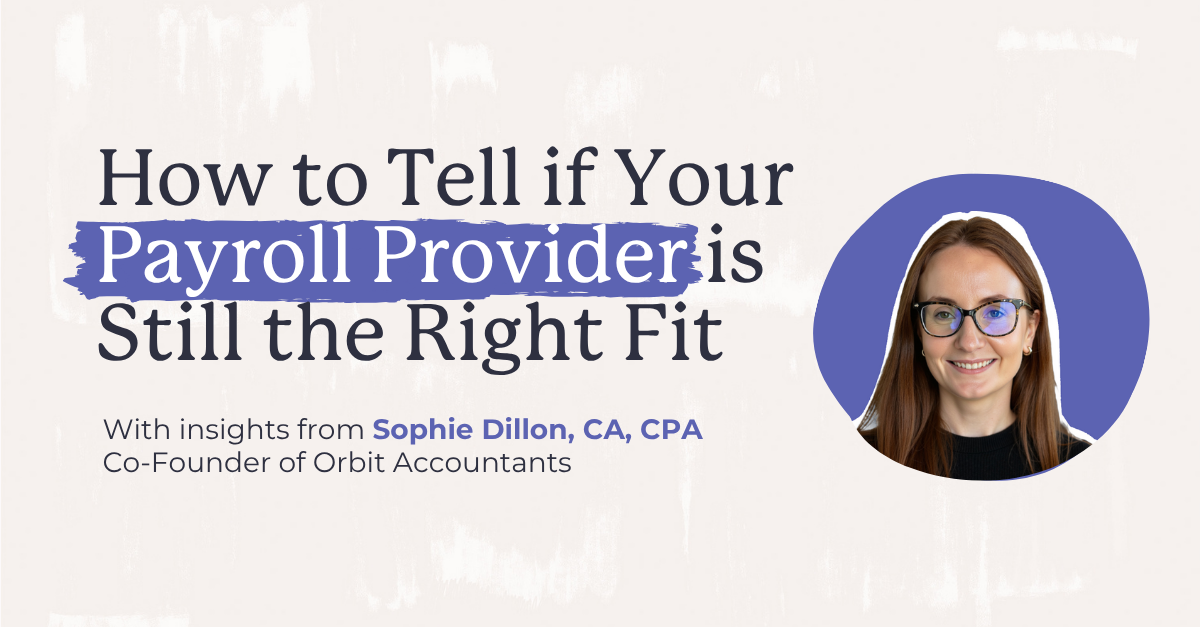Become an insider!
Get our latest payroll and small business articles sent straight to your inbox.
Have a task or project your small business needs taken care of, but it’s outside your team’s scope? An independent contractor can help get the job done.
Taking on the expertise of a contractor helps with handling tasks that your small business team can’t (or can’t yet — we see you doing your thing and growing out there!). Before seeking a contractor who can enhance the magic your business is already doing, you first need to understand two things:
- How independent contractor relationships are different from employer-employee relationships. (This affects how you pay them.)
- The options for paying independent contractors.
- How payroll for contractors is different if you choose that payment option.
Note: This blog is related to contractors that are Canadian residents. Non-resident contractors may be subject to the Income Tax Act Regulation 105 by the Canada Revenue Agency (CRA), which comes with different independent contractor taxes.
What are independent contractors?
The simplest explanation of independent contractors (often referred to simply as contractors) is that they’re self-employed individuals hired by businesses (or sometimes other individuals) to complete a job, project, task or service. Think graphic designers, copywriters, web designers, editors and more. These people aren’t employed members of your team but are hired to contribute work to your company. You become their client instead of them becoming your employee.
Another way to think about it is payer and payee instead of employer and employee.
Here’s a quick chart to give you a sense of what an independent contractor is and isn’t.
| An independent contractor is… | An independent contractor isn’t… |
| An individual who provides services for many businesses. | Just a construction worker! Independent contractors can work in any sort of field. |
| Hired directly and paid by a business to complete a project or service. | A temporary employee. Temporary employees or workers are brought onto a business’s team for short-term placements. These kinds of employees may even be sent from a temp agency, in which case they’d be paid paid by the agency, not the business they’re doing the work for. |
| An individual who sets their own fees or rates for services rendered. | |
| A business entity in their own right with their own legal requirements and financial risks. (They may even be a sole proprietor.) | |
| Responsible for their own payroll taxes and company benefits. |
Knowing the difference between an employee and contractor is not something to take lightly. Properly classifying them isn’t just about how to manage their funds in a payment system, either.
If you misclassify an employee as a contractor, for example, there are penalties, including interest, you’ll have to pay. The CRA will want all those tax payments your business will have missed.
There may also be some situations that land you in Canadian courts. There, the judge will look at what’s called the “facts of the working relationship” to decide the outcome. In other words, the courts will look at the details of the work being done to see whether it’s a payer-payee relationship or an employer-employee relationship.
What qualifies someone as an independent contractor?
This is a high level overview of how the CRA defines contractors:
- Degree of control: The contractor controls their schedule and work hours. Unlike with employees, the business owner or manager can’t set that for them.
- Tools and equipment: The contractor uses their own equipment to complete the job, including any phones, laptops, specialized tools or otherwise.
- Financial risk: This refers to whether the contractor has a chance of profit from the work or if they’ll take a loss. In other words, it’s up to this person to assess and figure out whether they’ll make money or not, not the business owner.
The CRA gives a more detailed break down, so definitely take a peek at their page, Employee or Self-Employed?
Scheduling independent contractors.
So, if small business owners don’t set a contractor’s schedule, does that mean they work willy nilly and you can’t expect the work to be done? Not at all!
All it means is that you can’t say to them, “Your shift is Monday to Friday from 9 am to 5 pm” (like you would with an employee). But you can discuss and agree upon deadlines to have the work completed by. It’s up to the contractor to carve out time during their day to complete the project and meet the deadline you both agreed to.
It’s a good idea to have a written contract so that everyone is on the same page and terms and payment are super clear to both parties. It also protects your business if there’s any sort of dispute between you two.
Canadian employment law and contractors.
Since contractors set their own time and rates, federal and provincial labour standards don’t apply to them the same way as employees. This doesn’t only mean hours and wages, but also to things like ending the working relationship.
While Canadian labour laws state that you need to give a reason for terminating an employee, you can cut ties with a contractor without doing so. Additionally, they aren’t entitled to severance pay the same way employees are.
Tax and benefit implications of independent contractors.
When you run payroll for your part-time or full-time employees, you collect amounts on each pay run for things like income tax, Canada Pension Plan (CPP) contributions, Employment Insurance (EI) contributions or company benefits. This is true even if you have remote employees.
Payroll for contractors uncomplicates it: In short, the employer doesn’t need to do that for their Canadian contractors. It’s on the contractor to acquire, track, pay and file any contributions or benefits for themselves, even if you choose to include paying contractors as a part of your payroll processing.
How to pay independent contractors?
It’s always nice to have options, and paying an independent contractor for their efforts comes with options. It’ll really be up to you and your small business needs and capacity for how you want to go about it. If you’re not sure how you should be recording it, check in with an accounting or bookkeeping professional. One who’s familiar with contractor payments or even payroll for contractors is best.
To start, here’s what you don’t need to worry about when paying Canadian independent contractors:
- Minimum wage
- Taxable income
- Tax deductions
- Employment insurance premiums
- Canada Pension Plan contributions
- Vacation pay / vacation time
- Health insurance and other benefits
- Maternity or parental leave
- Overtime pay
Now, let’s move on to some of the ways to pay them.
Note: Keep in mind that independent contractors may have sales tax (think GST, HST, PST) as a part of their fees. Given that, you’ll want to consider it regardless of which payment method you go with.
Paying independent contractors like you pay expenses
One way you can work with a contractor is this:
- The contractor gives you an invoice for their fees.
- You record it in your bookkeeping as an expense transaction.
The contractor might ask that you pay them in instalments or in a lump sum, but, in either instance, it’s handled outside of payroll.
Because it’s not a payroll transaction, it’d be included with other bills and business expenses like utilities and purchases. You’d also be able to easily track the sales tax on these kinds of transactions. (How you organize your expenses is, again, your call! You may even come up with a specific category for contractor expenses.)
In this case, you could pay the contractor in a number of ways, such as cash, etransfer or cheque.
Process payroll for contractors with your regular pay runs
Including payments to contractors as a part of your payroll might make sense if they’re a consistent part of your team. (Again, this is something you’ll want to check with a pro on.)
Given the different benefit and tax obligations, just keep in mind that your payroll for contractors is going to look a little different than the portion of the pay run for your employees. It won’t have deductions or contributions for CPP, EI and so forth. But, you may need to account for that sales tax mentioned before.
Including a contractor with your pay runs would give you the chance to pay them the same as your employees, such as by cheque, e-transfer or direct deposit. If you have a payroll software that includes contractor payroll, it simplifies the process even more.
Contractor payment transparency is key.
However you choose to record contractor payments in your small biz books, it’s a good idea to have a conversation with your contractor to set clear expectations of how they’ll be compensated for the work they do for you.
Don’t forget, this is a business relationship between you as the small business owner and this individual worker.
Contractor year-end forms.
Contractors receive year-end tax forms for the work they do. Because they report and pay their own taxes, Canadian workers need to show the CRA their earnings over the course of the calendar year.
While you’ll issue T4s to your employees and submit a T4 Summary for your business to the CRA, having a contractor means issuing T4A: Statement of Pension, Retirement, Annuity and Other Income slips in addition to submitting a T4A Summary for your business.
On the surface, a T4A slip looks a heck of a lot like a T4 slip, but since it’s used for independent contractors, you won’t see fields for amounts like CPP and EI. And, as you can imagine, the T4A Summary will reflect what’s on T4A forms.
This is a form you’ll either have to get a copy of and complete yourself to give to the contractor or, if you’re running payroll for contractors using software, it may generate this form and its details for you. (Psst! Wagepoint can!)
On your way to paying independent contractors.
And there you have it: A look at what contractors are and what paying independent contractors looks like in Canada. It starts with understanding how self-employed contractors are different than employees and how the relationship is different from an employment relationship. Then there’s deciding which method you want to use to actually pay the contractor.
While the payroll option might look a bit different from your standard processing for full-time, part time and remote workers, it doesn’t have to be an overly complicated ordeal.
Pay a contractor using Wagepoint
Paying independent contractors with Wagepoint is as simple as completing a pay run since they’ll be included in the process. When you set up an individual as a contractor in the system, it understands there are different legal obligations for this kind of worker so you don’t have to worry about it!
Sound like your kind of simplicity? Sign up for Wagepoint today.











